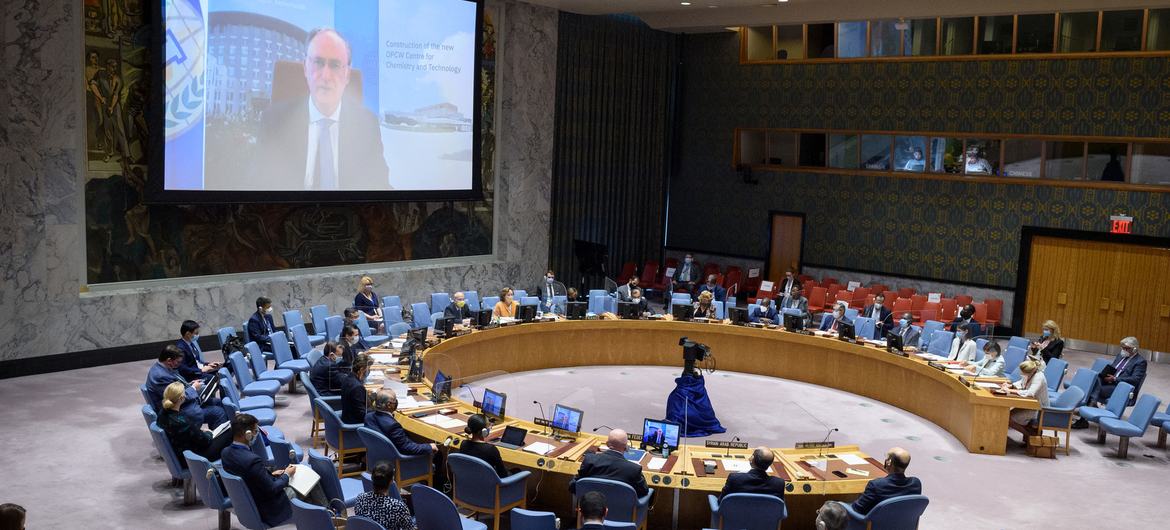Summary:
-
The third report of an Investigation and Identification Team, which was entrusted with finding out who used chemical weapons in particular situations in Syria, according to Fernando Arias, Director-General of the UN-supported OPCW, also said that the study had proof that on April 7, 2018, two yellow chlorine tanks were dropped from a Syrian air force helicopter flown by the government’s “Tiger Forces” and hit two civilian buildings.
-
Several members of the Council are apprehensive about Mr. Laborde’s involvement and the honesty of the team he is in charge of.
-
He said that the decision to take additional steps or actions will be up to the UN and the international community, adding that the report is now in the Security Council’s hands.
-
She praised the OPCW for being fair and professional in its work to keep the international ban on using chemical weapons in place.
-
In response to the impasse, the OPCW recently sent a “reduced” team to Syria to carry out “limited in-country actions.”
The third report of an Investigation and Identification Team, which was entrusted with finding out who used chemical weapons in particular situations in Syria, according to Fernando Arias, Director-General of the UN-supported OPCW,
He also said that the study had proof that on April 7, 2018, two yellow chlorine tanks were dropped from a Syrian air force helicopter flown by the government’s “Tiger Forces” and hit two civilian buildings.
The head of the Investigation and Identification Team, Santiago Oate Laborde, also spoke with Mr. Arias through a video link. Several members of the Council are apprehensive about Mr. Laborde’s involvement and the honesty of the team he is in charge of.
Douma “Lethal” incident
According to Mr. Arias, who described what most likely happened on April 7, 2018, the helicopter left the airbase between 19:10 and 19:40 local time and dropped the chlorine gas cylinders shortly after.
Because they believed it would provide better protection from the then-current conventional air strikes, some residents of the residential structures took refuge in the basements.
Some people moved to the upper floors of the building to find safety after becoming aware of the chemical’s existence and realizing that it was heavier than air.
The Director-General said that the upper floors, where the cylinder was releasing a lot of gas, and the basement, where the gas was growing, were “deadly places to live.”

Fernando Arias, who is in charge of the Organization for the Prohibition of Chemical Weapons (OPCW), talks to the Security Council (on screen) about what is happening in Syria.
Finding the culprits
Mr. Arias pointed out that the latest report expands on the findings of an OPCW fact-finding mission from 2019, which found that high levels of chlorine gas caused the catastrophe in Douma.
Between January 2021 and December 2022, the Investigation and Identification Team took over that task and conducted its investigation.
In addition to what happened in Douma, the Syrian military has been blamed for several other chemical weapons attacks.
The Director-General said that the “material gathered and evaluated not only supported and confirmed [the fact-finding mission’s] conclusions but also ruled out all other possible scenarios.”
Maximum standards
Mr. Arias said that the team’s conclusions came from looking at different pieces of evidence. He said that every report from the OPCW is based on the highest standards and best methods used by international agencies to come to sound conclusions.
This includes, among other things, witness statements, medical records, chemical and ballistic investigations, outside knowledge, computer modeling, satellite imagery, and photography.
He emphasized that the team must establish the facts and identify the culprits rather than acting as a court, and that it lacks the power to assign specific criminal blame.
He said that the decision to take additional steps or actions will be up to the UN and the international community, adding that the report is now in the Security Council’s hands.
Different possibilities
Santiago Oate Laborde, who is in charge of the OPCW Investigation and Identification Team, liked how fair and careful his team was.
He stated that because it depends on the voluntary participation of all states signatories to the Chemical Weapons Convention, including Syria, they are expected to grant access to the areas under investigation and give pertinent information, which Syria has mostly failed to do.
As part of their work, the team had to think about how Syria and its allies felt about the Douma incident and the possibility that terrorists staged it with the West’s help.
Mr. Laborde says that after looking at several theories, these options were ruled out because there was no evidence to back them up.
We are all in danger
The High Representative for Disarmament Affairs at the UN, Izumi Nakamitsu, also gave a report to the Council on Tuesday. She praised the OPCW for being fair and professional in its work to keep the international ban on using chemical weapons in place.
She claimed that since her previous briefing in January, the organization’s efforts to resolve outstanding questions regarding Syria’s initial and subsequent declarations regarding its chemical weapons program—first requested in 2013 when the Council mandated their complete elimination—have once again not advanced.
In response to the impasse, the OPCW recently sent a “reduced” team to Syria to carry out “limited in-country actions.”
She said it was important to find and punish anyone who would dare to break international law by using chemical weapons, calling such actions “reprehensible” and a “threat to us all.”

